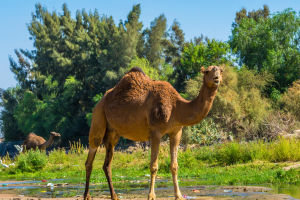The camel, often referred to as the "ship of the desert," is one of the most remarkable animals, perfectly adapted to thrive in the harsh, arid environments of deserts.
Its unique physical and behavioral traits allow it to survive in conditions that would be unbearable for most other species.
With its ability to endure extreme heat, scarce water, and limited food sources, the camel has become an essential companion to desert-dwelling humans and an iconic symbol of resilience. One of the most notable adaptations of the camel is its ability to conserve water. In the desert, water is scarce, and camels have developed a remarkable system for retaining moisture.
They can drink large quantities of water in a short amount of time, often consuming up to 40 gallons in one sitting. Their bodies store this water in specialized tissues, and they can go for days, sometimes even weeks, without drinking again. During this period, they conserve water by reducing the amount lost through perspiration and urination. This adaptation allows them to survive in an environment where access to fresh water is minimal.
The camel's thick fur also plays a crucial role in its desert survival. While it may seem counterintuitive to have a thick coat in such a hot climate, the fur actually helps regulate the camel's body temperature.
During the day, when temperatures soar, the fur reflects the sun's rays, preventing excessive heat absorption. At night, when the temperature drops drastically, the fur acts as an insulator, keeping the camel warm.
This temperature regulation allows the camel to remain comfortable in both scorching heat and freezing cold desert nights. In addition to its fur, the camel has specialized features that help it cope with the desert's extreme temperatures. Its long, thick eyelashes and the ability to close its nostrils protect its eyes and respiratory system from sand and dust storms, which are common in the desert.
The camel's large, padded feet are perfectly suited for traversing the sandy terrain, preventing it from sinking into the soft sand and allowing it to walk long distances with ease.
The camel's diet is another area where it has adapted to the harsh desert environment. Unlike many animals that require a steady supply of fresh food, camels can survive on sparse vegetation. They are herbivores that feed on thorny plants, dry grasses, and shrubs that other animals would find inedible.
The camel is a true marvel of evolution, with its many adaptations making it the ideal animal for surviving in the harsh desert environment. From its ability to conserve water to its unique physical features, the camel is a symbol of resilience and endurance in one of the most challenging ecosystems on Earth.
Its ability to thrive in the desert has earned it a place in the hearts of people who rely on it for transportation, food, and companionship, making it a vital part of desert life!


